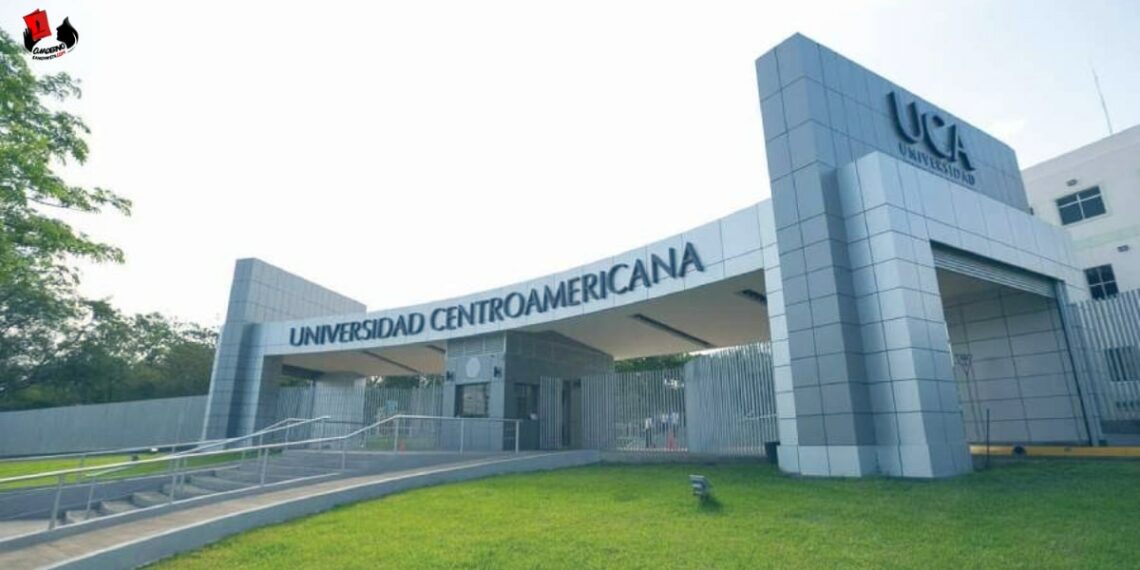Germán Van de Velde, August 18th 2023
The Jesuits founded the now-defunct Central American University (UCA) in the 1960s. Headquartered in Managua, it was the first private university to be created in Central America. Intellectuals from a diverse array of religious affiliations participated in this project.
During the dictatorship the UCA was not looked upon with disfavor because it was considered to be aligned with the development interests of the Somozas. The dictatorship assumed that this institution could counteract the strength of the student movement at the National Autonomous University of Nicaragua (UNAN),[1] which never happened because the student movement only grew stronger and stronger as the final insurrection approached.
Right after the triumph of the Sandinista Popular Revolution, the now defunct UCA had serious staffing problems. Teaching in higher education had not been consistently supported. Low salaries and limited educational resources and teaching materials discouraged the people from engaging in this revolutionary activity that was so necessary for the training of academic professionals.
In order to solve this problem, international cooperation was sought from foreign professors and through student teachers. For example, in the second year after the triumph of the revolution, approximately 60% of the instructors at the former UCA were foreigners; this figure later dropped to 25%. An attitude of solidarity and cooperation helped solve that problem.
Up until the early 1990s, the former UCA held a position against imperialist power and strongly criticized neoliberalism as a political and economic model. In the early 1990s, the now defunct UCA participated in the protests against the Violeta Barrios de Chamorro administration to demand that 6% of the national budget be allocated to the universities, as specified in the constitution. However, the UCA’s engagement in that struggle progressively cooled off, until it finally reached complicit silence. Little by little, it abandoned positions criticizing imperialist power, changing from a university with a preferential option for the poor to a university at the service of big money.
By the mid-1990s, the former school terminated majors in humanistic fields such as philosophy, arts, and letters, closing the Human Rights Program and the Culture Department, among others. Curriculum changes began to appear, eliminating educational content that might question global neoliberalism as a system that creates injustices, inequalities, and asymmetry between states and within countries between social classes.
From 1994-1995 onwards, the leadership of the now-defunct UCA focused on going after, sanctioning, and destroying the University Student Center of the Central American University (CEUUCA) and its leaders. This was aimed at obliterating the leadership of the National Student Union of Nicaragua (UNEN), which still exists and whose members are young revolutionaries.
In the second half of the ‘90s, to 2000 and beyond, the university marginalized and minimized courses in sociology and social work. These humanistic majors were disparaged, the document center was canceled, and the contracts of many Sandinista instructors were terminated. These students were sent to the worst classrooms, these majors were not promoted, and classes were moved from normal hours to unusual ones.
Many offices or programs at the now-defunct UCA—which in the 1980s and early 1990s had a vocation for social service, henceforth became commodified (Nitlapan), which went from conducting research for social action to granting loans for profit—a true vampire feeding on the working class.[2]
This was when the cost of enrollment skyrocketed, not only in terms of monthly tuition, but also fees to receive grades and degrees. They no longer charged by the month or four-month period, but for each class. All of this turned the former UCA into an institution for elites, placing it on the list of the most expensive universities in Nicaragua and Central America.
Starting in 2007, the now-defunct UCA begin to operate as the ideological center of the counterrevolution. It promoted the creation of digital battle fronts which served as platforms to spread fake news throughout the country and establish opinion narratives against the Sandinista government. These facilities were used to prepare “leadership” courses and certificate programs funded by USAID and the NED, which trained the misnamed “student leaders” who were key players during the attempted coup d’etat.
The attempted coup of 2018 was incubated on the campus of the former UCA, which served as the barracks and command post of the coup mongers. This academic institution became a den of criminals, cyber terrorists, and mouthpieces for chaos. At that stage, the now-defunct UCA went from serving tiny groups of political actors who wanted—and still want—to destroy the model of human development being implemented in Nicaragua, to directly serving the US government.
Finally, during the last three fiscal years (2020, 2021, and 2022) the now-defunct UCA did not submit financial statements indicating the origin of its donations and the ultimate beneficiaries. The former UCA failed to provide detailed breakdowns of revenue and expenses, balance sheets, or details on donations (source, provenance, and beneficiaries), and its Board of Directors expired on 18 March 2022 and was not renewed (with no final beneficiary identified). All of this violates the rule of law and legal framework established by Article 34, clauses 3, 7, 24, 25, 26, 26.1, 26.3, 27 and Article 35.7 of Law 1115, the General Law on the Regulation and Control of Non-Profit Entities.
Such has been the deplorable transformation of the former UCA throughout its history. The government of Nicaragua, as State regulator, is responsible for enforcing the law. 16 August 2023 will go down in Nicaraguan history as the day that the Central American University became the now-defunct UCA, and took on the name “Casimiro Sotelo Public University” in honor of the distinguished student leader who took the message of revolution to young people at the Central American University in the 1960s.
The Sandinista Popular Revolution—our Revolution—is fundamentally guided by a vocation of serving the people and serving human beings; protecting peace; and promoting popular education in a spirit of solidarity and genuine cooperation to continue building a Nicaragua that is Blessed and Always Free.




